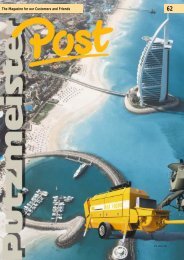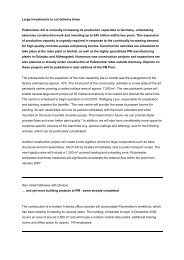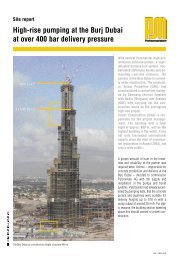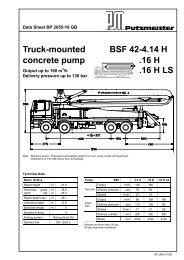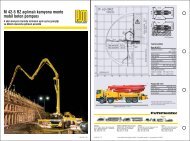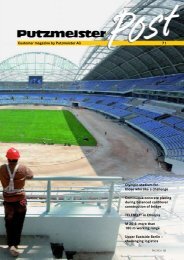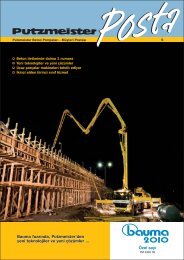“New Harbour” in Doha/Qatar - Putzmeister Holding GmbH
“New Harbour” in Doha/Qatar - Putzmeister Holding GmbH
“New Harbour” in Doha/Qatar - Putzmeister Holding GmbH
Create successful ePaper yourself
Turn your PDF publications into a flip-book with our unique Google optimized e-Paper software.
On site<br />
On site<br />
German Unity Transport Project 8:<br />
Tunnel construction for the new high<br />
speed ICE rail l<strong>in</strong>k between Nuremberg<br />
and Berl<strong>in</strong><br />
a mat was used to form a protective layer<br />
over the seal. The fill<strong>in</strong>g concrete<br />
was placed directly beh<strong>in</strong>d the foot<br />
formwork carriage <strong>in</strong> sections to create<br />
an ideal area for follow-up work on the<br />
<strong>in</strong>ner shell. The company Kern provided<br />
the fleet of mach<strong>in</strong>es for the <strong>in</strong>ner shell,<br />
which were set up <strong>in</strong> the north while<br />
work was already underway and then<br />
supplied from that end.<br />
Vault<strong>in</strong>g concrete<br />
16<br />
[ALPINE BeMo Tunnell<strong>in</strong>g <strong>GmbH</strong>, Site manager<br />
Claus Melzer, August 2012]<br />
The new high speed rail l<strong>in</strong>k between<br />
Ebensfeld and Erfurt is 107 km long,<br />
passes through 22 tunnels with a total<br />
length of 41 km and over 29 viaducts<br />
with a total length of 12 km. The 1.3 km<br />
long Baumleite tunnel is located on the<br />
edge of the Thur<strong>in</strong>gian Forest between<br />
the Thur<strong>in</strong>gian communities of Theuern,<br />
Truckenthal and Grümpen. A 40 m deep<br />
shaft structure as well as crossways and<br />
escape tunnels have been built next to<br />
the tw<strong>in</strong>-track ma<strong>in</strong> tunnel.<br />
DB Netz AG commissioned ALPINE BeMo<br />
Tunnell<strong>in</strong>g <strong>GmbH</strong>, Niederlassung West<br />
(formerly Beton- und Monierbau Innsbruck<br />
<strong>GmbH</strong>, NLW) to construct the<br />
Baumleite tunnel.<br />
Inner shell<br />
As specified <strong>in</strong> the tender, areas of the<br />
<strong>in</strong>ner shell with more than 30 cm of<br />
water were l<strong>in</strong>ed with plastic seal<strong>in</strong>g<br />
membranes and an impermeable concrete<br />
structure. The entrance blocks and<br />
the first m<strong>in</strong>ed blocks were <strong>in</strong>tended to<br />
form an impermeable concrete structure.<br />
The two <strong>in</strong>ner shells were 45 cm and 60<br />
cm thick and a 45 cm thick shell was<br />
added to the structure, extend<strong>in</strong>g up to<br />
the edges. A total of about 43,000 m³ of<br />
<strong>in</strong>ner shell concrete, 2,000 t of concrete<br />
re<strong>in</strong>forcements and 26,000 m³ of fill<strong>in</strong>g<br />
concrete were placed.<br />
For logistical reasons, it was necessary<br />
to service the tunnel from both ends. In<br />
the south, an additional storage area was<br />
created so that the seal and concrete re<strong>in</strong>forcements<br />
<strong>in</strong> the tunnel floor could be<br />
<strong>in</strong>stalled from this end. It was therefore<br />
necessary to place a levell<strong>in</strong>g layer beforehand<br />
us<strong>in</strong>g a vibrat<strong>in</strong>g beam and a<br />
stiff C20/25 concrete - a task which was<br />
completed after 10 days of cont<strong>in</strong>uous<br />
operation. Instead of protective concrete,<br />
It was possible to adapt the fleet of commissioned<br />
formwork carriages accord<strong>in</strong>g<br />
to requirements. The concrete re<strong>in</strong>forcement<br />
carriage was equipped with a pallet<br />
truck. The weight of the vault<strong>in</strong>g carriage<br />
was 140 kN/m² due to the concret<strong>in</strong>g<br />
technology used. Particular attention<br />
was paid to keep<strong>in</strong>g the stopend formwork<br />
as lightweight and manageable as<br />
possible <strong>in</strong> spite of high static requirements.<br />
A fold<strong>in</strong>g support member was<br />
used at the critical po<strong>in</strong>t along the foot<br />
section. Steel girders were used <strong>in</strong> the<br />
rema<strong>in</strong><strong>in</strong>g section up to the abutment so<br />
that 80 mm thick fac<strong>in</strong>g timber could be<br />
used. The steel girders <strong>in</strong> the roof area<br />
were replaced with timber girders due to<br />
p M 24 at the north entrance<br />
Inner shell concrete formula:<br />
C30/37X0 XC4 XF1 XA1<br />
320 kg/m³ CEM II/A-S 42,5 R<br />
Deuna PZ Doppel<br />
35 kg/m³ SFA Schwenk Zement KG<br />
(Kremer)<br />
167 l/m³ water<br />
799 kg/m³ 0/2<br />
306 kg/m³ 2/8<br />
685 kg/m³ 8/16<br />
1,15 % Sky 651 BASF<br />
15<br />
17<br />
10 11



![Data sheet BSA 1005 D SV (TB 2206) [.pdf; 459.58 kb] - Putzmeister](https://img.yumpu.com/51174022/1/184x260/data-sheet-bsa-1005-d-sv-tb-2206-pdf-45958-kb-putzmeister.jpg?quality=85)
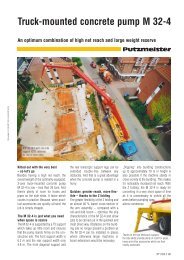
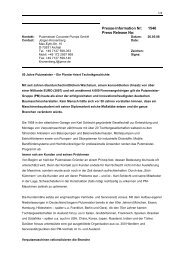
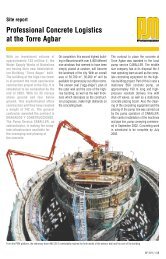
![Typenblatt CS 3095 [.pdf; 202.40 kb] - Putzmeister](https://img.yumpu.com/50530164/1/184x260/typenblatt-cs-3095-pdf-20240-kb-putzmeister.jpg?quality=85)
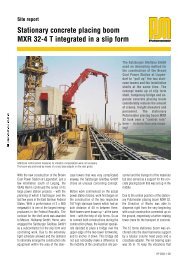
![M 47 Broşürü [.pdf; 527.92 kb] - Putzmeister](https://img.yumpu.com/49631771/1/190x141/m-47-brosuru-pdf-52792-kb-putzmeister.jpg?quality=85)
